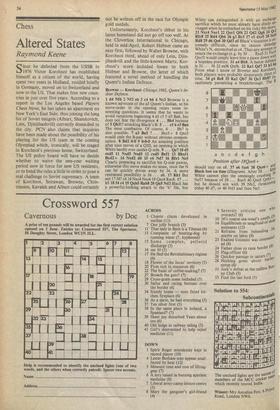Chess
Altered States
Raymond Keene
Since he defected from the USSR in 1976 Victor Korchnoi has established himself as a citizen of the world, having spent two years in Holland, resided briefly in Germany, moved on to Switzerland and now to the US. That makes four new coun- tries in just over five years. According to a report in the Los Angeles based Players Chess News, he has taken an apartment on New York's East Side, thus joining the long list of Soviet emigres (Alburt, Shamkovich, Lein, Djinjihashvili) currently domiciled in the city. PCN also claims that inquiries have been made about the possibility of his playing for the US team in the coming Olympiad which, ironically, will be staged in Korchnoi's previous home, Switzerland. The US policy board will have to decide whether to waive the one-year waiting period now in force for new US residents, or to bend the rules a little in order to pose a real challenge to Soviet supremacy. A team of Korchnoi, Seirawan, Browne, Chris- tiansen, Kavalek and Alburt could certainly
not be written off in the race for Olympic gold medals.
Unfortunately, Korchnoi's debut in his latest homeland did not go off too well. At the Cloverline International in Chicago, held in mid-April, Robert HUbner came an easy first, followed by Walter Browne, with Korchnoi third, ahead of only Lein, Djin- jihashvili and the little-known Martz. Kor- chnoi's score included losses to both Hubner and Browne, the latter of which featured a novel method of handling the Queen's Indian Defence.
Browne — Korchnoi: Chicago 1982, Queen's In- dian Defence.
1 d4 Nf6 2 Nf3 e6 3 c4 b6 4 Nc3 Browne is a known advocate of the a3 Queen's Indian, so his move-order in the opening raises some in- teresting questions. It seems that he wants to avoid variations beginning 4 a3 c5 5 d5 Ba6, but does not fear the divergence 4 ... Bb4 because of 5 Qb3!? attacking Black's B. 5 ... c5 6 e3 Ba6 The most combative. Of course, 6 ... Bb7 is also possible. 7 a3 Ba5 7 ... Bxc3 + 8 Qxc3 would cede the B-pair without obvious compen- sation. 8 Bd2 0-0 9 0-0-0 An amazing position after nine moves of a QID, an opening in which White hardly ever castles Q-side. 9 ... Qe7 10 d5 exd5 11 Nxd5 Nxd5 12 cxd5 Bxfl 13 Rhxfl Bxd2 + 14 Nxd2 d6 15 e4 Nd7 16 Rfel Ne5 Clearly preparing to sacrifice his Q-side pawns, otherwise this move makes no sense, since the N can be quickly driven away by f4. A more restrained possibility is 16 ... a6. 17 Kbl But not 17 f4? c4 18 Nxc4 Nxc4 19 Qxc4 Rac8. 17 ... b5 18 f4 c4 19 Qxb5 FEab8 20 Qa5 Nd3 Black has a powerful-looking attack in the 'b' file, but
White can extinguished it with an exchange sacrifice which he must already have dimly en- visaged when he embarked on his risky 9th move. 21 Nxc4 Nxel 22 Qxel 23 Q6 24 Qc! Rfc8 25 Rd4 Qh6 26 g3Qf Rc6 5 27Q ed2 5 dxeg5 28 fg° Rd8 29 d6 Qe6 30 Qd3 a5 Black's situation is ex- tremely difficult, since he cannot dislodge White's N, entrenched at c4. Thus any attempt to return the exchange (e.g. by 30 ... Rxe5 31 NxeS Qxe5) would simply leave him a pawn down with a hopeless position. 31 a4 RbS. A better defence is 31 ... f6 32 exf6 Qxf6. 32 Kal Qd7 33 b3 From what I know of Browne and Korchna, both players were probably desperately short of time. 34 g4 Re8 35 Ka2 Qb7 36 Qe3 Rbr In- cautiously permitting a breakthrough. The
and
should stay on e8. 37 e6 fxe6 38 Qxe6 -1" vhs Black lost on time (Diagram). After 38 • • • '19 White cannot play the seemingly crushin8 Ne5? because of 39 ... RxeS 40 Qxe5 Qxb3÷' but he should win with 39 Nb2, threatening either 40 d7, or 40 Nd3 and then Ne5. Position after 38Qxe6+






































 Previous page
Previous page